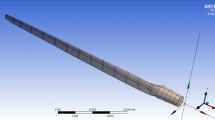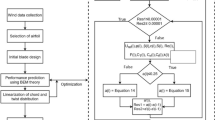Abstract
Although the upwind configuration is more popular in the field of wind energy, the downwind one is a promising type for the offshore wind energy due to its special advantages. Different configurations have different aerodynamic performance and it is important to predict the performance of both downwind and upwind configurations accurately for designing and developing more reliable wind turbines. In this paper, a numerical investigation on the aerodynamic performance of National Renewable Energy Laboratory (NREL) phase VI wind turbine in downwind and upwind configurations is presented. The open source toolbox OpenFOAM coupled with arbitrary mesh interface (AMI) method is applied to tackle rotating problems of wind turbines. Two 3D numerical models of NREL phase VI wind turbine with downwind and upwind configurations under four typical working conditions of incoming wind velocities are set up for the study of different unsteady characteristics of the downwind and upwind configurations, respectively. Numerical results of wake vortex structure, time histories of thrust, pressure distribution on the blade and limiting streamlines which can be used to identify points of separation in a 3D flow are presented. It can be concluded that thrust reduction due to blade-tower interaction is small for upwind wind turbines but relatively large for downwind wind turbines and attention should be paid to the vibration at a certain frequency induced by the cyclic reduction for both configurations. The results and conclusions are helpful to analyze the different aerodynamic performance of wind turbines between downwind and upwind configurations, providing useful references for practical design of wind turbine.
Similar content being viewed by others
References
Duque, EPN, Van Dam CP, Brodeur RR, Chao DD (1999). Navier-Stokes analysis of time-dependent flows about wind turbines. Proceedings of the 1999 3rd ASME/JSME Joint Fluids Engineering Conference, San Francisco, USA, 1–6.
Farrell P, Maddison J (2011). Conservative interpolation between volume meshes by local Galerkin projection. Computer Methods in Applied Mechanics and Engineering, 200(1), 89–100. DOI: 10.1016/j.cma.2010.07.015
Hand MM, Simms DA, Fingersh LJ, Jager DW, Cotrell JR, Schreck S, Larwood SM (2001). Unsteady aerodynamics experiment phase VI: Wind tunnel test configuration and available data campaigns. National Renewable Energy Laboratory, Golden, Colorado, USA, NREL/TP-500-29955. DOI: 10.2172/787980
Hong LX, Moller B (2012). Feasibility study of China’s offshore wind target by 2020. Energy, 48(1), 268–277. DOI: 10.1016/j.energy.2012.03.016
Issa RI (1986). Solution of the implicitly discretised fluid flow equations by operator-splitting. Journal of Computational physics, 62(1), 40–65. DOI: 10.1016/0021-9991(91)90191-M
Jadhav HT, Roy R (2014). Effect of turbine wake on optimal generation schedule and transmission losses in wind integrated power system. Sustainable Energy Technologies and Assessments, 7, 123–135. DOI: 10.1016/j.seta.2014.04.001
Janajreh I, Talab I, Macpherson J (2010a). Numerical simulation of tower rotor interaction for downwind wind turbine. Modelling and Simulation in Engineering, 2010(10), 23–45. DOI: 10.1155/2010/860814
Janajreh I, Qudaih R, Talab I, Ghenai C (2010b). Aerodynamic flow simulation of wind turbine: Downwind versus spwind configuration. Energy Conversion and Management, 51(8), 1656–1663. DOI: 10.1016/j.enconman.2009.12.013
Jasak H (1996). Error analysis and estimation for the finite volume method with applications to fluid flows. PhD thesis, Imperial College London, University of London.
Jeong J, Hussain F (1995). On the identification of a vortex. Journal of Fluid Mechanics, 285(69), 69–94. DOI: http://dx.doi.org/10.1017/S0022112095000462
Kim SH, Shin HK, Joo YC, Kim KH (2015). A study of the wake effects on the wind characteristics and fatigue loads for the turbines in a wind farm. Renewable Energy, 74, 536–543. DOI: 10.1016/j.renene.2014.08.054
Li Y, Paik KJ, Xing T, Carrica PM (2012). Dynamic overset CFD simulations of wind turbine aerodynamics. Renewable Energy, 37(1), 285–298. DOI: 10.1016/j.renene.2011.06.029
Menter FR (1994). Two-equation eddy-viscosity turbulence models for engineering applications. AIAA Journal, 32(8), 1598–1605. DOI: 10.2514/3.12149
Menter FR (2009). Review of the shear-stress transport turbulence model experience from an industrial perspective. International Journal of Computational Fluid Dynamics, 23(4), 305–316. DOI: 10.1080/10618560902773387
Moshfeghi M, Song Yajun, Xie Yonghui (2012). Effects of near-wall grid spacing on SST-K-ω model using NREL phase VI horizontal axis wind turbine. Journal of Wind Engineering and Industrial Aerodynamics, 107–108, 94–105. DOI: 10.1016/j.jweia.2012.03.032
Patankar SV (1980). Numerical heat transfer and fluid flow. Washington, DC, Hemisphere Publishing Corp., USA.
Sanderse B, Van der Pijl SP, Koren B (2011). Review of computational fluid dynamics for wind turbine wake aerodynamics. Wind Energy, 14(7), 799–819. DOI: 10.1002/we.458
Sherer SE, Scott JN (2005). High-order compact finite-difference methods on general overset grids. Journal of Computational Physics, 210(2): 459–496. DOI: 10.1016/j.jcp.2005.04.017
Steinhoff J (1994). Vorticity confinement: A new technique for computing vortex dominated flows. In: Caughey DA, Hafez MM (Eds.), Frontiers of Computational Fluid Dynamics. Wiley, New York, 235–264.
Wang Q, Zhou H, Wan DC (2012). Numerical simulation of wind turbine blade-tower interaction. Journal of Marine Science and Application, 11(3), 321–327. DOI: 10.1007/s11804-012-1139-9
Wu Jie, Wang Zhixin, Wang Guoqiang (2014). The key technologies and development of offshore wind farm in China. Renewable and Sustainable Energy Reviews, 34(C), 453–462. DOI: 10.1016/j.rser.2014.03.023
Zahle F, Sørensen NN, Johansen J (2009). Wind turbine rotor-tower interaction using an incompressible overset grid method. Wind Energy, 12(6), 594–619. DOI: 10.1002/we.327
Zhao WC, Cheng P, Wan DC (2014). Numerical computation of aerodynamic performances of NREL offshore 5-MW baseline wind turbine. Proceedings of the Eleventh (2014) ISOPE Pacific Asia Offshore Mechanics Symposium, Shanghai, China, 13–18.
Zhao WC, Wan DC (2014). Wind turbine impacts on its semi-submersible floating supporting system for phase II of OC4. Proceedings of the Twenty-fourth (2014) International Ocean and Polar Engineering Conference, Busan, Korea, 294–301.
Zhou H, Wan DC (2014). Numerical simulation of the unsteady flows around wind turbines with different blades numbers. Chinese Journal of Hydrodynamics, 29(4), 444–453. (in Chinese) DOI: 10.3969/j.issn1000-4874.2014.04.009
Author information
Authors and Affiliations
Corresponding author
Additional information
Foundation item: Supported by the National Natural Science Foundation of China (Grant Nos. 51379125, 51411130131, 11432009), the National Key Basic Research Development Plan (973 Plan) Project of China (Grant No. 2013CB036103), High Technology of Marine Research Project of the Ministry of Industry and Information Technology of China, ABS(China), and the Program for Professor of Special Appointment (Eastern Scholar) at Shanghai Institutions of Higher Learning (Grant No. 2013022).
Rights and permissions
About this article
Cite this article
Zhou, H., Wan, D. Numerical investigations on the aerodynamic performance of wind turbine: Downwind versus upwind configuration. J. Marine. Sci. Appl. 14, 61–68 (2015). https://doi.org/10.1007/s11804-015-1295-9
Received:
Accepted:
Published:
Issue Date:
DOI: https://doi.org/10.1007/s11804-015-1295-9




